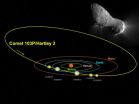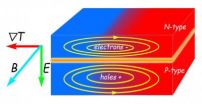Using a 'systems biology' approach to look under the hood of an aggressive form of breast cancer
Study is the first to examine how blood protein levels change as cancer develops -- long before the disease is clinically detectable
2011-08-01
(Press-News.org) SEATTLE – Using a "systems biology" approach – which focuses on understanding the complex relationships between biological systems – to look under the hood of an aggressive form of breast cancer, researchers for the first time have identified a set of proteins in the blood that change in abundance long before the cancer is clinically detectable. The findings, by co-authors Christopher Kemp, Ph.D., and Samir Hanash, M.D., Ph.D., members of Fred Hutchinson Cancer Research Center's Human Biology and Public Health Sciences divisions, respectively, are published online ahead of the Aug. 1 print issue of Cancer Research.
Studying a mouse model of HER2-positive breast cancer (cancer that tests positive for a protein called human epidermal growth factor receptor 2) at various stages of tumor development and remission, the researchers found that even at the very earliest stages the incipient tumor cells communicate to normal tissues of the host by sending out signals and recruiting cells, while the host tissues in turn respond to and amplify the signals.
"It is really a 'systems biology' study of cancer, in that we simultaneously examined many genes and proteins over time – not just in the tumor but in blood and host tissues," Kemp said. "The overall surprising thing we found was the degree to which the host responds to cancer early in the course of disease progression, and the extent of that response. While a mouse – or presumably a human – with early-stage cancer may appear normal, our study shows that there are many changes occurring long before the disease can be detected clinically. This gives us hope that we should be able to identify those changes and use them as early detection tools with the ultimate goal of more effective intervention."
Traditionally, it has been thought that tumor cells shed telltale proteins into the blood or elicit an immune response that can lead to changes in blood-protein levels. "What is new here is that the predominant protein signals we see in blood originate from complex interactions and crosstalk between the tumor cells and the local host microenvironment," Kemp said.
Until now, such tumor/host interactions have been primarily studied one gene at a time locally, within the tumor; this is the first study to monitor the systemic response to cancer in a preclinical tumor model, tracking the abundance of cancer-related proteins throughout tumor induction, growth, and regression. Of approximately 500 proteins detected, up to a third changed in abundance; the number increased with cancer growth and decreased with tumor regression.
"We found a treasure trove of proteins that are involved in a variety of mechanisms related to cancer development, from the formation of blood vessels that feed tumors to signatures of early cancer spread, or metastasis," Kemp said.
Proteins associated with wound repair were most prevalent during the earliest stages of cancer growth, which could point to a potential target for early cancer detection. "Rather than blindly search for cancer biomarkers, an approach based on comprehensive understanding of the systems biology of the disease process is likely to increase the chances to identify blood-based biomarkers that will work in the clinic," Kemp said.
The next steps will involve selecting the most promising protein candidates found in mice and determining whether the same circulating proteins are markers of early breast cancer development in humans, with the ultimate goal of designing a blood test for earlier breast cancer detection.
###
The Paul G. Allen Family Foundation, the National Cancer Institute Mouse Models of Human Cancer Consortium and the Canary Foundation funded the research.
At Fred Hutchinson Cancer Research Center, our interdisciplinary teams of world-renowned scientists and humanitarians work together to prevent, diagnose and treat cancer, HIV/AIDS and other diseases. Our researchers, including three Nobel laureates, bring a relentless pursuit and passion for health, knowledge and hope to their work and to the world. For more information, please visit fhcrc.org.
ELSE PRESS RELEASES FROM THIS DATE:
SOHO watches a comet fading away
2011-08-01
On Nov. 4, 2010, NASA's EPOXI spacecraft came within 450 miles of Comet Hartley 2, a small comet not even a mile in diameter, which takes about six and a half years to orbit the sun. Designated officially as 103P/Hartley 2, the comet thus became the fifth for which scientists have collected close-up images.
But the comet was also observed from another spacecraft: the Solar and Heliospheric Observer (SOHO), better known for its observations of the sun. Together, the two returned data about what appears to be an irregular comet, belching chunks of ice and losing water at ...
Fresh Produce Clothing's Summer-Fall Collections Feature Unique Pieces of Wearable Works of Art
2011-08-01
Fresh Produce customers can make an artful statement when they wear the eclectic prints featured in its latest collections of effortless and spirited looks. The inspired prints are available in a variety of new styles and fabrications from cool cotton voile to comfy cotton jersey and versatile rayon-lycra.
This summer's standout print is the Blue Tahitian Flower. Fresh Produce women adore this romantic watercolor-inspired motif. Its look and feel is "pure summer" with beautiful tropical flowers captured in soft, watery hues and translated to new chic tunics, ...
An unexpected clue to thermopower efficiency
2011-08-01
Scientists at the U.S. Department of Energy's Lawrence Berkeley National Laboratory (Berkeley Lab) and their colleagues have discovered a new relation among electric and magnetic fields and differences in temperature, which may lead to more efficient thermoelectric devices that convert heat into electricity or electricity into heat.
"In the search for new sources of energy, thermopower – the ability to convert temperature differences directly into electricity without wasteful intervening steps – is tremendously promising," says Junqiao Wu of Berkeley Lab's Materials ...
Boloco Earns Another 'Green' Star
2011-08-01
Back in March 2008 boloco, a chain of inspired burrito restaurants, became the first fast-casual chain in New England to become a Certified Green Restaurant by the Green Restaurant Association (GRA). But when boloco found out an even higher level of certification could be achieved - well, let's just say they reached for the stars. Boloco is now the first chain* of restaurants to become a 2 Star Certified Green Restaurant across all of their 17 locations.
For each of boloco's 17 locations to earn the GRA's rigorous two-star certification, they had to be inspected and ...
New study outlines economic and environmental benefits to reducing nitrogen pollution
2011-08-01
New, York, NY—July 28, 2011—A new study co-authored by Columbia Engineering professor Kartik Chandran and recently published in the journal, Environmental Science & Technology, shows that reducing nitrogen pollution generated by wastewater treatment plants can come with "sizable" economic benefits, as well as the expected benefits for the environment.
Chandran was one of five scientists from around the U.S. who worked on the study, along with James Wang of NOAA's Air Resources Laboratory and formerly of Environmental Defense Fund (EDF); Steve Hamburg, Chief Scientist ...
Genetic evidence clears Ben Franklin
2011-08-01
HOUSTON -- (July 28, 2011) -- The DNA evidence is in, and Ben Franklin didn't do it.
Genetic tests on more than 1,000 Chinese tallow trees from the United States and China show the famed U.S. statesman did not import the tallow trees that are overrunning thousands of acres of U.S. coastal prairie from Florida to East Texas.
"It's widely known that Franklin introduced tallow trees to the U.S. in the late 1700s," said Rice University biologist Evan Siemann, co-author the new study in this month's American Journal of Botany. "Franklin was living in London, and he had tallow ...
Scientists report dramatic carbon loss from massive Arctic wildfire
2011-08-01
In a study published in this week's issue of Nature, Marine Biological Laboratory (MBL) senior scientist Gauis Shaver and his colleagues, including lead author Michelle Mack of the University of Florida, describe the dramatic impacts of a massive Arctic wildfire on carbon releases to the atmosphere. The 2007 blaze on the North Slope of the Alaska's Brooks Mountain Range released 20 times more carbon to the atmosphere than what is annually lost from undisturbed tundra.
As wildfires increase in frequency and size along Alaska's North Slope, the team contends the disturbances ...
WSO2 Presents Workshops on Enterprise Integration and Security in the Cloud
2011-08-01
Enterprise IT architects and developers face the dual demands of optimizing their service-oriented architecture (SOA) implementations on-premise while also seeking ways to leverage the cloud. This month, WSO2 (http://wso2.com?080111w) delivers technical workshops designed to address two of enterprises' top SOA challenges: enterprise integration and security in the cloud.
Security in the Cloud: August 4, 2011, Palo Alto, CA
The WSO2 "Security in the Cloud" workshop will identify the security challenges that can stop or slow a move to the cloud, review open ...
Breakthrough lights way for RNA discoveries
2011-08-01
NEW YORK (July 28, 2011) -- The ability to tag proteins with a green fluorescent light to watch how they behave inside cells so revolutionized the understanding of protein biology that it earned the scientific teams who developed the technique Nobel Prizes in 2008. Now, researchers at Weill Cornell Medical College have developed a similar fluorescent tool that can track the mysterious workings of the various forms of cellular RNA.
In the July 29 issue of Science, the Weill Cornell investigators report how they developed an RNA mimic of green fluorescent protein (GFP) ...
Mannan oligosaccharides offer health benefits to pigs
2011-08-01
Feeding mannan oligosaccharides (MOS) can fine-tune the immune system of pigs, suggests a new University of Illinois study.
"When it comes to keeping pigs healthy, there are some potentially powerful tools we can use in the diet besides antibiotics," said James Pettigrew, U of I professor of animal science. "We have a tendency to think that we can administer health through a needle, by giving pigs antibiotics, and even through systems like all-in/all-out pig flow. These are important, but there are also many health benefits we can realize through the diet."
MOS is a ...
LAST 30 PRESS RELEASES:
Numbers in our sights affect how we perceive space
SIMJ announces global collaborative book project in commemoration of its 75th anniversary
Air pollution exposure and birth weight
Obstructive sleep apnea risk and mental health conditions among older adults
How talking slows eye movements behind the wheel
The Ceramic Society of Japan’s Oxoate Ceramics Research Association launches new international book project
Heart-brain connection: international study reveals the role of the vagus nerve in keeping the heart young
Researchers identify Rb1 as a predictive biomarker for a new therapeutic strategy in some breast cancers
Survey reveals ethical gaps slowing AI adoption in pediatric surgery
Stimulant ADHD medications work differently than thought
AI overestimates how smart people are, according to HSE economists
HSE researchers create genome-wide map of quadruplexes
Scientists boost cell "powerhouses" to burn more calories
Automatic label checking: The missing step in making reliable medical AI
Low daily alcohol intake linked to 50% heightened mouth cancer risk in India
American Meteorological Society announces Rick Spinrad as 2026 President-Elect
Biomass-based carbon capture spotlighted in newly released global climate webinar recording
Illuminating invisible nano pollutants: advanced bioimaging tracks the full journey of emerging nanoscale contaminants in living systems
How does age affect recovery from spinal cord injury?
Novel AI tool offers prognosis for patients with head and neck cancer
Fathers’ microplastic exposure tied to their children’s metabolic problems
Research validates laboratory model for studying high-grade serous ovarian cancer
SIR 2026 delivers transformative breakthroughs in minimally invasive medicine to improve patient care
Stem Cell Reports most downloaded papers of 2025 highlight the breadth and impact of stem cell research
Oxford-led study estimates NHS spends around 3% of its primary and secondary care budget on the health impacts of heat and cold in England
A researcher’s long quest leads to a smart composite breakthrough
Urban wild bees act as “microbial sensors” of city health.
New study finds where you live affects recovery after a hip fracture
Forecasting the impact of fully automated vehicle adoption on US road traffic injuries
Alcohol-related hospitalizations from 2016 to 2022
[Press-News.org] Using a 'systems biology' approach to look under the hood of an aggressive form of breast cancerStudy is the first to examine how blood protein levels change as cancer develops -- long before the disease is clinically detectable




